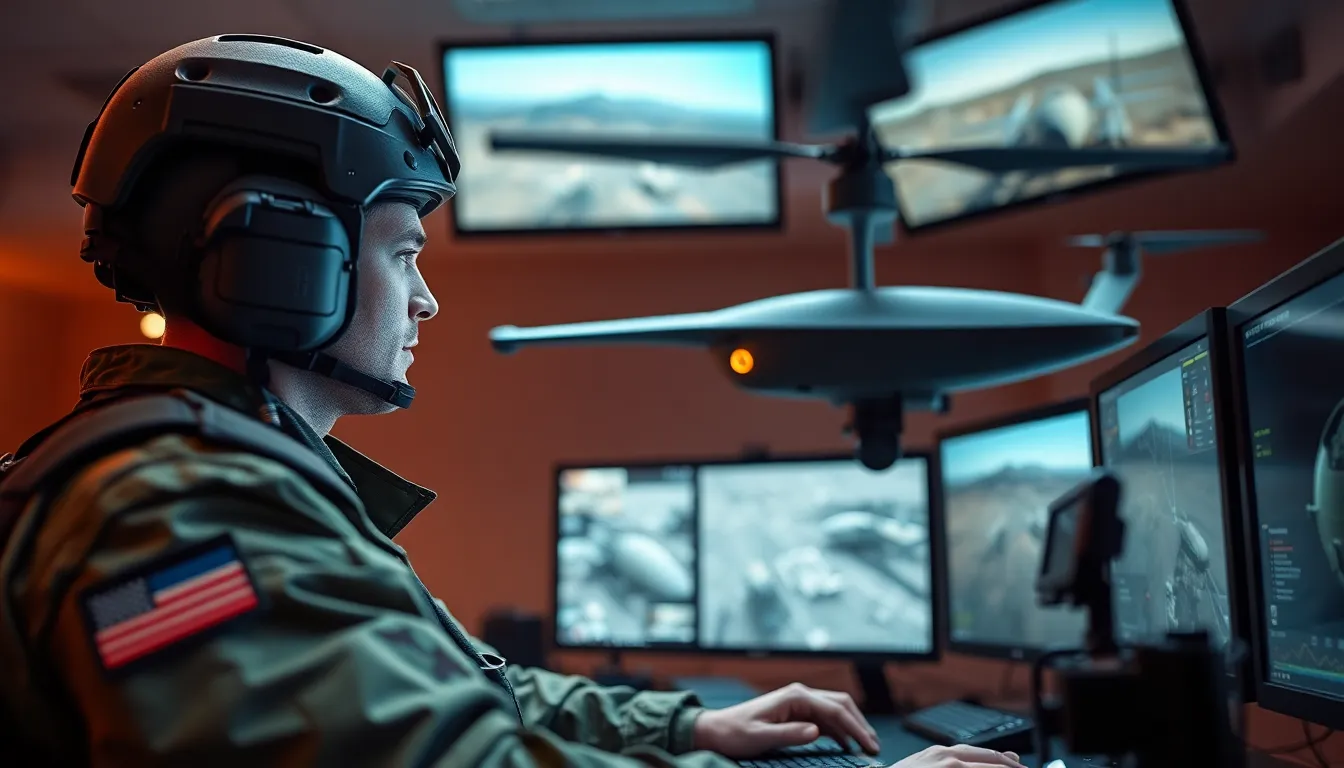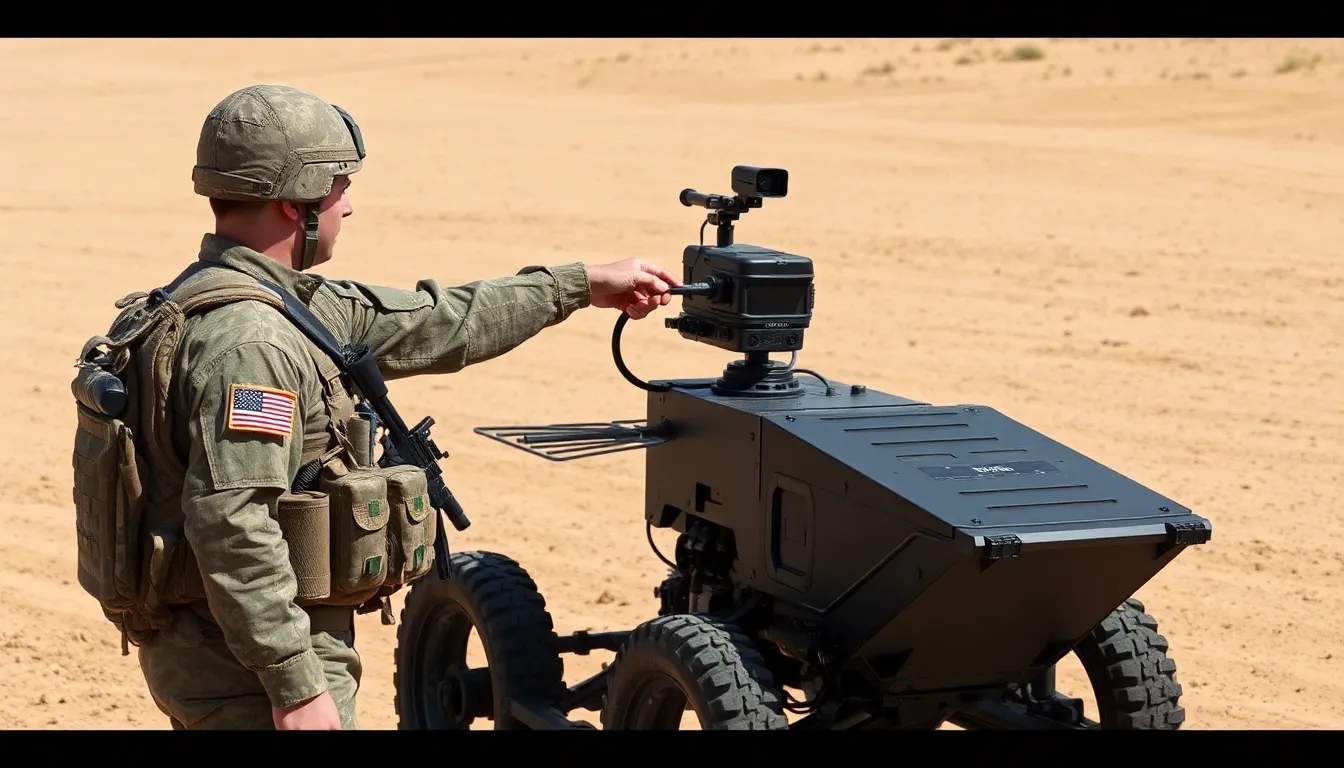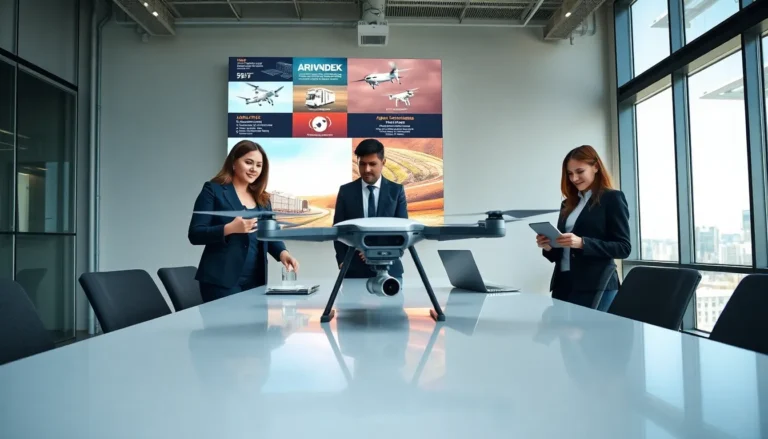Table of Contents
ToggleIn a world where technology is advancing faster than a caffeinated cheetah, military robots are stepping onto the battlefield with an impressive array of capabilities. These mechanical marvels are not just souped-up toys for defense nerds; they’re transforming how armies operate, making missions safer and more efficient. Imagine sending in a robot to do the heavy lifting while soldiers enjoy a well-deserved coffee break—now that’s a win-win!
From drones soaring through the skies to ground robots that can disarm explosives, military robots are redefining warfare. They’re like the Swiss Army knives of the battlefield, equipped with tools and features that can tackle almost any challenge. As nations invest in these high-tech soldiers, the future of warfare is looking less like a sci-fi movie and more like a strategic chess game—only with a lot more beeping and whirring.
Overview of Military Robots
Military robots encompass a range of advanced technologies that enhance operational capabilities in various environments. These machines include unmanned aerial vehicles, ground robots, and underwater drones. Unmanned aerial vehicles, commonly known as drones, perform surveillance, reconnaissance, and precision strikes. High-tech ground robots handle tasks such as bomb disposal, scouting, and logistics support.
Roles of these robots in modern warfare include increasing efficiency and minimizing risks to personnel. Ground robots can neutralize explosive devices, safeguarding human soldiers from potential harm. Autonomous systems reduce the need for troops in high-conflict zones, which can improve mission outcomes.
Countries worldwide recognize the value of military robots and invest significantly in their development. Research and development programs focus on enhancing artificial intelligence, improving navigation, and increasing operational range. Enhanced communication systems facilitate coordination between robots and human operators, fostering teamwork on the battlefield.
Not all military robots serve combat roles. Logistics robots assist with supply chain management, delivering essential materials. Medical evacuation robots transport injured soldiers, ensuring timely care while reducing human risk.
Ongoing advancements in military robotics promise further integration into defense strategies. Resulting capabilities will likely redefine how military operations are conducted. Continuous assessment of ethical implications is crucial as robots take on more responsibility in warfare settings. Balancing innovation with safety remains a priority in military robotics development.
Types of Military Robots

Military robots can be categorized into several distinct types, each serving specialized functions in modern warfare. This classification includes unmanned aerial vehicles, unmanned ground vehicles, and underwater drones.
Unmanned Aerial Vehicles (UAVs)
UAVs operate extensively in surveillance, reconnaissance, and air support roles. These drones provide real-time intelligence, gathering critical data without risking human lives. Equipped with advanced sensors and cameras, UAVs can monitor enemy positions and track movements over vast areas. Major deployments of UAVs include combat missions, logistics support, and targeted strikes. Notable examples include the MQ-9 Reaper and the RQ-4 Global Hawk. Both enhance operational awareness while allowing forces to engage targets from a safe distance.
Unmanned Ground Vehicles (UGVs)
UGVs perform various functions, ranging from reconnaissance to bomb disposal and logistics. These robotic ground systems operate in challenging environments, reducing the risk to soldiers on the battlefield. UGV types include transportation bots for resupply missions and robots designed for explosive ordnance disposal. Some well-known UGV models are the PackBot and the MAARS robot, which offer robust capabilities in hostile terrains. Enhanced by artificial intelligence, UGVs can navigate autonomously, making them essential in modern military operations.
Applications of Military Robots
Military robots play critical roles in modern warfare, enhancing capabilities across various domains. They are essential for tasks that improve efficiency and safety for military personnel.
Surveillance and Reconnaissance
Drones serve as pivotal tools for surveillance and reconnaissance missions. Unmanned aerial vehicles (UAVs) like the MQ-9 Reaper provide real-time intelligence, allowing forces to monitor enemy movements effectively. Equipped with advanced sensors, these machines collect data over vast areas, reducing the need for human presence in high-risk zones. Moreover, UAVs can conduct long-duration flights, significantly extending the operational reach of military forces. Tactical reconnaissance robots, deployed on the ground, offer additional capabilities by gathering intelligence in challenging environments. Each component contributes to a comprehensive situational awareness, empowering decision-making processes.
Logistics and Supply
Logistics robots streamline supply chain operations on the battlefield. Unmanned ground vehicles (UGVs) transport essential supplies, ensuring timely delivery to troops in various locations. The PackBot, for instance, can navigate rugged terrains to deliver food, ammunition, and medical supplies without risking human lives. Using autonomous navigation systems, these robots operate efficiently even in complex environments. Their capabilities extend beyond simple transportation; they also aid in inventory management, optimizing resource distribution. Maintaining logistics flow enhances overall mission effectiveness, allowing military personnel to focus on critical tasks while ensuring essential support continues uninterrupted.
Advantages of Using Military Robots
Military robots offer numerous advantages that enhance operational capabilities and soldier safety. First, they reduce human exposure to dangerous situations, allowing robots to undertake high-risk tasks like bomb disposal. Furthermore, the use of unmanned aerial vehicles (UAVs) such as the MQ-9 Reaper enables real-time intelligence gathering without risking pilot lives.
Their ability to operate in adverse environments increases mission success rates. Many ground robots, like the PackBot, excel in reconnaissance missions, effectively navigating terrain that may endanger human personnel. Additionally, logistics robots ensure efficient supply distribution, transporting essential resources directly to troops on the front lines.
Efficiency in communication stands out as another key benefit. Military robots leverage advanced artificial intelligence for enhanced situational awareness and decision-making. The integration of UAVs and unmanned ground vehicles (UGVs) allows seamless coordination during missions, strengthening overall operational effectiveness.
Cost-saving opportunities emerge from utilizing military robots. By deploying these technologies for labor-intensive tasks, forces can allocate personnel to more strategic roles, improving resource management. Continuous advancements in robot design and functionality also promise increased versatility across various missions.
Safety enhancements remain a top priority. Robots equipped with surveillance capabilities can watch high-risk regions, collecting intel while keeping soldiers out of harm’s way. This results in a decreased potential for casualties during dangerous operations.
Countries acknowledge the potential of military robots and invest in their development. Research focuses on improving navigation, communication, and autonomous functionalities, thereby enhancing the robots’ integration into modern warfare. These innovative technologies keep evolving, solidifying the advantages military robots bring to contemporary defense strategies.
Challenges and Ethical Considerations
Military robots present significant challenges and ethical dilemmas. One primary concern involves the potential for autonomous weapons making life-and-death decisions without human intervention. Such developments raise questions about accountability when robots fail or cause unintended harm.
Complexity in operations can also cause issues, as military robots rely heavily on software and algorithms. Software malfunctions might result in operational failures, potentially jeopardizing missions and safety. Human-animal interactions generate additional challenges, as military personnel must maintain effective communication with robots in unpredictable environments.
Concerns about privacy and surveillance capabilities influence the deployment of UAVs. Their ability to collect data raises ethical questions regarding civilian oversight and the potential for misuse. Infringing on privacy rights could lead to public outcry and diminish trust in military actions.
Widespread adoption of military robots also intensifies the conversation about job displacement. Automation in the military could lead to reduced roles for personnel, raising concerns about career paths for future service members. Societal implications emerge as well, with debates surrounding whether robots should replace humans in high-stakes environments.
Regulations and international agreements may struggle to keep pace with rapid advancements in military robotics. Establishing norms for their use becomes increasingly critical as technology evolves. Protocols for engagement and accountability must develop alongside technological capabilities to prevent misuse or escalation in conflict situations.
Debates around ethics in military robotics underscore the importance of a cautious approach to innovation. Balancing technological advancement with human oversight remains essential to ensure responsible deployment and adherence to ethical standards in warfare.
Future of Military Robots
Advancements in military robots continue to reshape modern warfare. Increased capabilities in artificial intelligence drive innovations across unmanned systems. Invested funds enhance navigation and communication, allowing better coordination between robots and human operators.
Utilization of autonomous drones for reconnaissance missions increases operational efficiency. Unmanned ground vehicles transport essential supplies, optimizing resource distribution on the battlefield. Ground robots are equipped for explosive ordnance disposal, reducing risks to soldiers.
Emerging technologies focus on developing ethical frameworks for military robots. Accountability remains a primary concern with autonomous systems making life-and-death decisions. Civilian safety and privacy issues arise as drones gather extensive surveillance data.
Countries worldwide are exploring regulations to keep pace with robotic advancements. International agreements play a critical role in establishing norms for responsible military use. Collaboration among nations encourages the development of ethical guidelines within military robotics.
Ongoing research aims to perfect navigation systems and enhance situational awareness. The integration of machine learning improves decision-making processes during missions. Additionally, increased automation may shift service members’ roles in the military, creating debates about job displacement.
Countries are prioritizing the balance between technological innovations and ethical considerations. Responsible development ensures alignment with human oversight in warfare. As military robots evolve, their integration will challenge existing defense strategies and necessitate ongoing assessments.
Military robots are undeniably transforming the landscape of modern warfare. Their ability to perform high-risk tasks not only enhances operational efficiency but also prioritizes the safety of soldiers. As nations continue to invest in advanced technologies, the integration of artificial intelligence and improved communication systems will further elevate the capabilities of these machines.
However, the rise of military robots also brings forth significant ethical dilemmas and challenges that must be addressed. The balance between innovation and responsibility is crucial in ensuring that these advancements serve to protect rather than endanger. Ongoing discussions surrounding regulations and accountability will shape the future of military robotics, ultimately determining how they fit into the broader context of warfare and humanitarian considerations.






